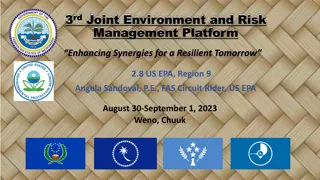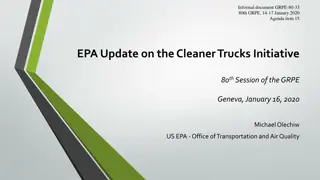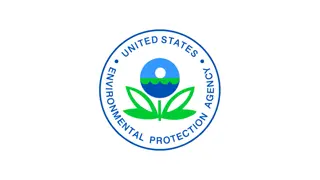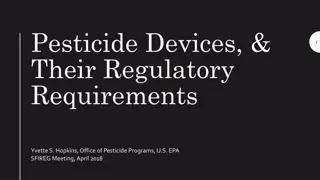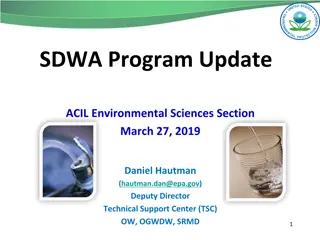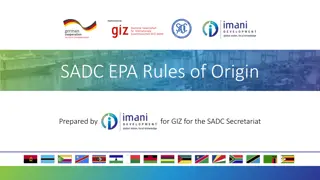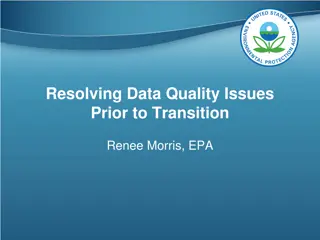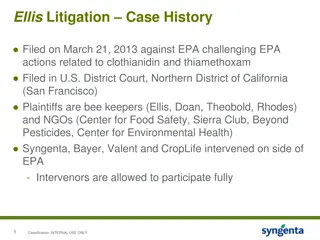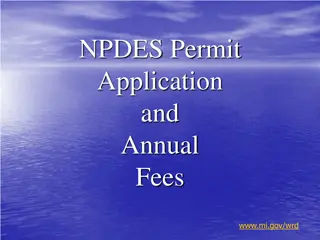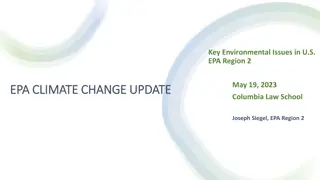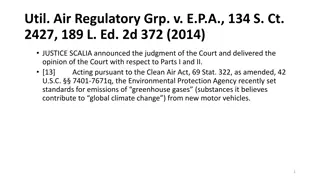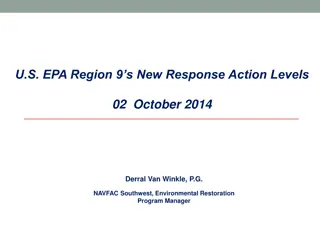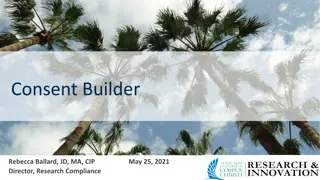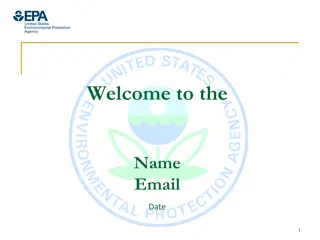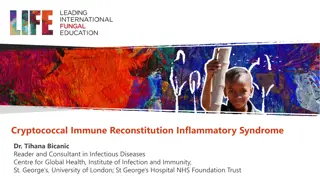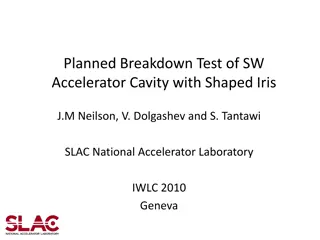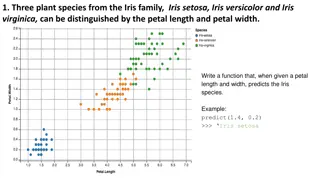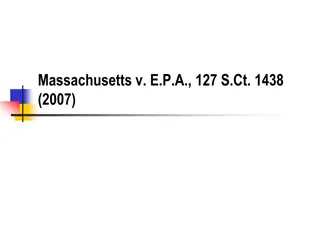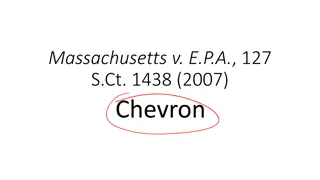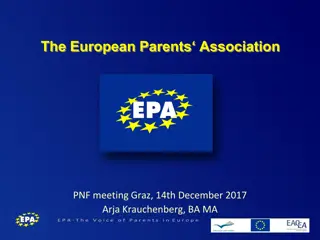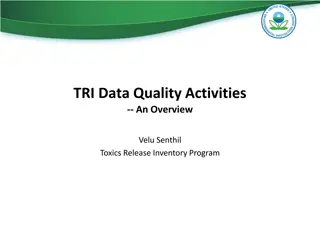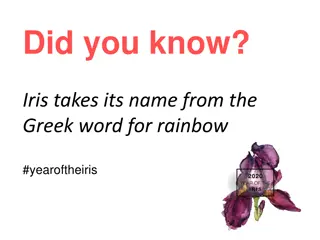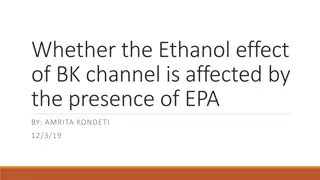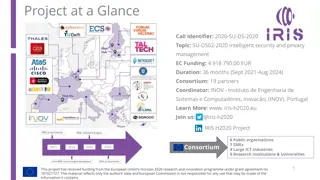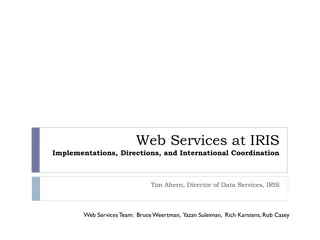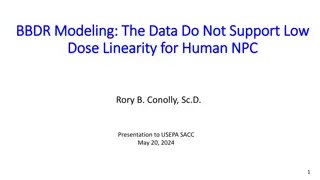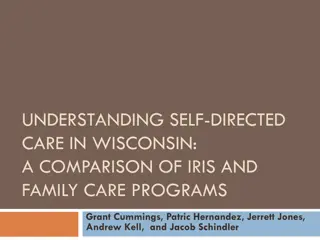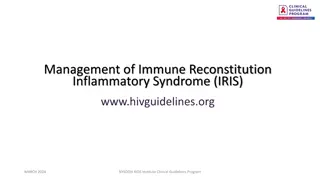Climate Justice & Disadvantaged Communities: Environmental Issues in US EPA Region 2
Climate justice and the impact on disadvantaged communities are key environmental issues addressed by Adriana Espinoza, Deputy Commissioner for Equity & Justice in US EPA Region 2. The initiative identifies and prioritizes disadvantaged communities based on multiple criteria, including environmental
5 views • 18 slides
Comprehensive Guide to End Point Assessment (EPA) for Apprenticeship
This detailed guide provides an overview of the End Point Assessment (EPA) process for apprenticeships, including timelines, requirements, and key steps such as project presentation, vocational competence discussion, and scenario evaluation. It covers aspects like completing the apprenticeship, Gate
4 views • 30 slides
Enhancing Synergies for a Resilient Tomorrow: EPA Regional Initiatives
The 3rd Joint Environment and Risk Management Platform, led by the US EPA Region 9, focuses on safeguarding environmental health in the US Affiliated Pacific Islands. The initiative aims to address deficiencies in water infrastructure, waste management, and hazardous waste sites. A new Circuit Rider
1 views • 6 slides
EPA's PFAS Strategic Roadmap: Commitments to Action 2021-2024
EPA's PFAS Strategic Roadmap, initiated by Administrator Michael Regan, outlines key actions from 2021-2024 to safeguard public health and the environment from Per- and Polyfluoroalkyl Substances (PFAS). It includes a comprehensive approach, timelines, and support for state efforts. PFAS are a group
5 views • 13 slides
EPA Cleaner Trucks Initiative Update
EPA is developing the Cleaner Trucks Initiative to tackle NOx emissions from new heavy-duty trucks. The ANPR was signed to gather feedback, with plans for NPRM in late Spring 2020. The program aims for nationwide emissions reductions through aligning with CARB, modernizing requirements, and enhancin
3 views • 6 slides
EPA Air Quality Monitoring System Overview
The EPA operates air quality monitoring stations across the United States, utilizing a cloud-based system with secure connections. Data from these stations, though lagging, covers various substrates like CO, Ozone, and Wind Speed. Users can access monitored parameters, set up the EPA API with a key
0 views • 11 slides
Understanding Regulatory Requirements for Pesticide Devices
Pesticide devices, as defined by FIFRA, play a crucial role in trapping, destroying, repelling, or mitigating pests or plant and animal life. While not required to be registered with the EPA, these devices are regulated under FIFRA sections 2(q)(1), 7, and 8, with specific labeling and packaging req
0 views • 10 slides
EPA's PFAS Action Plan and Drinking Water Activities Update
EPA's PFAS Action Plan, unveiled in February 2019, outlines a comprehensive approach to addressing PFAS challenges nationally. The Agency is committed to regulating PFOA and PFOS and proposes nationwide monitoring for PFAS in drinking water. Additionally, the Technical Support Center (TSC) is active
0 views • 10 slides
Technical Soundness of EU-SADC EPA Rules of Origin
The implementation and technical soundness of Rules of Origin under the EU-SADC EPA are crucial for the utilization of trade preferences. Compliance with rules of origin is essential for receiving tariff preferences, but drafting these rules accurately is challenging. Recommendations include specify
4 views • 12 slides
Resolving Data Quality Issues Prior to Transition at EPA
This content covers the process of resolving data quality issues before transitioning data at the U.S. Environmental Protection Agency (EPA). It includes information on different types of data quality checks, reviews, and corrections conducted by the EPA to ensure accurate and reliable data. The con
1 views • 9 slides
Litigation Case History Against EPA: Ellis v. EPA
Filed in 2013 by beekeepers and NGOs against EPA, the Ellis litigation case challenges EPA actions on clothianidin and thiamethoxam registrations. The case includes dismissed claims under APA and FIFRA, with a pending ruling on ESA violations. The litigation schedule involves ongoing Alternative Dis
0 views • 5 slides
Understanding NPDES Permit Application and Fees in Michigan
NPDES permits in Michigan regulate the discharge of municipal, industrial, and commercial wastewater, as well as stormwater, into state surface waters under Act 451. The permit fees vary based on the type of discharge, with separate fees for stormwater and non-stormwater discharges. Industrial storm
1 views • 13 slides
Eco-Remediation Goals Development Training Overview
This presentation by Mark Sprenger from the U.S. EPA discusses the development of Ecological Preliminary Remediation Goals (PRGs). It covers the process steps, assumptions, risk information activities, and resources related to ecological risk assessment within the EPA's programs. The training module
0 views • 53 slides
EPA Climate Change Update: Key Environmental Issues and Funding Overview
EPA Region 2 presented key environmental issues in the U.S. related to climate change and introduced the Inflation Reduction Act (IRA) with significant investments to reduce emissions. The act allocates funding across various sectors such as electricity, manufacturing, energy efficiency, and transpo
0 views • 28 slides
EPA Regulations and Clean Air Act: Legal Interpretation
The case of Util. Air Regulatory Grp. v. E.P.A. (2014) addresses whether the EPA's regulations on motor-vehicle greenhouse gas emissions trigger permitting requirements for stationary sources under the Clean Air Act. It delves into the provisions of the Act concerning both stationary and moving sour
0 views • 79 slides
Guidelines on EPA Region 9 Response Action Levels for TCE Contamination
EPA Region 9 has established response action levels for TCE contamination, with tiered concentrations for different exposure scenarios. The State of California provides guidance aligned with these levels. DTSC concurs with EPA's residential and industrial response levels but recommends consultation
0 views • 10 slides
Understanding the Informed Consent Process in iRIS
Learn how to efficiently navigate the Informed Consent Builder feature in iRIS for creating consent forms. The process involves selecting a consent template, merging it with application data, editing the document, and submitting it for review within the system.
0 views • 14 slides
The EPA: A Legacy of Environmental Protection since 1970
The Environmental Protection Agency (EPA) was established in 1970 following significant environmental disasters to protect human health and the environment. Before the EPA, pollution and toxic chemicals posed serious threats to air, water, and land, leading to sickness and death. The EPA's mission i
0 views • 13 slides
EPA Rule 40 CFR Part 63 Subpart HHHHHH Overview
EPA Rule 40 CFR Part 63 Subpart HHHHHH, also known as The Refinisher Rule, sets standards for hazardous air pollutants in paint stripping and surface coatings operations. The rule aims to control emissions of target hazardous air pollutants in collision centers and surrounding areas. It outlines req
0 views • 20 slides
Understanding Cryptococcal Immune Reconstitution Inflammatory Syndrome
Cryptococcal Immune Reconstitution Inflammatory Syndrome (C-IRIS) is a condition where rapid reversal of immunodeficiency triggers exaggerated inflammatory reactions in response to Cryptococcus antigens. It can manifest as either Unmasking IRIS or Paradoxical IRIS, with common CNS presentations incl
0 views • 10 slides
Understanding IRIS Reporting in Healthcare
IRIS reporting is a critical component in ensuring federal funding for Graduate Medical Education. It involves submitting the Medicare Cost Report to CMS based on the Intern and Resident Information System (IRIS). This comprehensive process includes attestation, checklist completion, reporting missi
0 views • 10 slides
Enhancing Iris Recognition with Circular Contourlet Transform
Iris recognition is a reliable biometric identification method due to the iris's unique properties. By incorporating the Circular Contourlet Transform (CCT) into the classical iris recognition algorithm, the feature extraction process can be enhanced to improve recognition rates under unconstrained
0 views • 14 slides
Breakdown Test of SW Accelerator Cavity with Shaped Iris
In a study by J.M. Neilson, V. Dolgashev, and S. Tantawi at SLAC National Accelerator Laboratory, planned breakdown tests were conducted on a single-cell SW accelerator cavity with shaped iris geometries. The research assessed breakdown dependence, different iris parameters, and compared elliptical
0 views • 10 slides
Helpful Functions for Iris Species Prediction and Dot Number Calculation
The provided content includes a function to predict Iris species based on petal length and width (Iris setosa, Iris versicolor, Iris virginica) and a function to calculate the number of dots in a figure pattern. The Iris prediction function uses specific criteria for each species, and the dot number
1 views • 6 slides
Legal Battle Over EPA's Authority on Greenhouse Gas Regulation
The case of Massachusetts v. EPA revolves around a petition filed in 1999 requesting the EPA to regulate greenhouse gas emissions from new motor vehicles. Despite acknowledging its authority to regulate CO2 emissions, the EPA denied the petition in 2003, citing reasons related to the Clean Air Act.
0 views • 36 slides
Analysis of EPA's Authority to Regulate GHGs under the Clean Air Act
Massachusetts v. EPA (2007) addressed whether the Clean Air Act allows regulation of greenhouse gases (GHGs). EPA's findings on the rulemaking petition questioned its authority to regulate GHGs despite previous claims. The Act mandates EPA to issue regulations on air pollutants emitting from new mot
0 views • 32 slides
European Parents Association - Empowering Parents in Education
The European Parents Association (EPA) was founded in Milan in 1985 and represents over 150 million European citizens through its member associations across Europe. EPA advocates for parents' rights in education and emphasizes the importance of parental involvement and support in their children's le
0 views • 14 slides
Character Analysis of "Under the Net" by Iris Murdoch
Under the Net" by Iris Murdoch is a 1954 novel dedicated to Raymond Queneau, exploring the lives of characters like James Donahue, Hugo Belfounder, Anna Quentin, Sadie Quentin, Dave Gellman, Peter O'Finney, and Mrs. Tinckham. The novel delves into themes of love, philosophy, and identity through the
0 views • 15 slides
Ensuring Quality of TRI Data: EPA's Efforts and Guidelines
EPA plays a crucial role in ensuring the quality of Toxics Release Inventory (TRI) data through year-round efforts such as guidance, outreach, training, and assistance. Measures like using readily available information, making reasonable estimates, and following data flow and quality activities help
0 views • 25 slides
Fascinating Facts About Irises - Year of the Iris
Irises, named after the Greek word for rainbow, are stunning flowers with unique characteristics. They feature three upward petals called standards and three downward sepals known as falls. The sepals act as landing pads for pollinators, guiding them towards nectar. Irises come in a variety of color
0 views • 9 slides
Update on Changes to EPA Emissions Inventory Tool
Updates to the EPA Emissions Inventory Tool include changes in table structures, documentation headers, and reporting requirements. The new Bridge Tool simplifies reporting processes and streamlines data categories for more efficient emissions reporting. Access the tool through the provided links fo
0 views • 33 slides
The Impact of EPA on Ethanol Effect of BK Channel
Alcohol Use Disorders (AUDs) are a significant issue in society, with gene and environmental factors contributing to alcoholism. Ethanol, when consumed excessively, can severely impact physical and behavioral health by altering neurotransmitter levels. The presence of Eicosapentaenoic Acid (EPA), an
0 views • 15 slides
Managing Intraoperative Floppy Iris Syndrome in Cataract Surgery
Effective management of intraoperative floppy iris syndrome in cataract surgery involves specific maneuvers such as reducing aspiration flow rate, using mechanical iris expansion devices, and avoiding large or posterior incisions. This condition is characterized by progressive pupil constriction, ir
0 views • 6 slides
Understanding the EPA's Ozone Advance Program and Clean Air Act
The content covers key information about the EPA's Ozone Advance Program, including the basics of ozone, the Clean Air Act requirements, designation vs. classification, classification deadlines, and marginal classification requirements. It explains the formation of ozone, the importance of reducing
0 views • 40 slides
IRIS December Bi-Monthly Meeting: General Comments on Stopping Rules and Research Opportunities
General comments were made at the IRIS December Bi-Monthly Meeting regarding the Stopping Rules document and research opportunities for NCEA to enhance the quality of assessments. Concerns were raised about the restrictions on published/unpublished research and the potential misinterpretations of th
0 views • 12 slides
IRIS H2020 Project - Enhancing Cybersecurity for SMART CITIES
The IRIS H2020 project is dedicated to enhancing cybersecurity for SMART CITIES by developing a framework that supports European CERT and CSIRT networks in detecting, sharing, and responding to cybersecurity threats in IoT and AI-driven ICT systems. The project aims to minimize the impact of cyberse
0 views • 5 slides
Exploring Web Services at IRIS: Implementations and Coordination
Discover the world of web services at IRIS through a detailed exploration of implementations, international coordination efforts, and the team behind these endeavors. Learn about the definition of web services, practical examples, and the various data and processing services offered by IRIS to suppo
0 views • 24 slides
Analysis of BBDR Modeling for Human NPC Dose Linearity
The BBDR modeling for human NPC dose linearity is examined through various studies and updates from 2003 to 2024. Key aspects include formaldehyde BBDR, regulatory acceptance/rejection, EPA/IRIS concerns, and the 2023 BBDR model update addressing main issues. The 2023 BBDR model presents two version
0 views • 10 slides
A Comparison of IRIS and Family Care Programs in Wisconsin
IRIS (Include, Respect, I-Self-Direct) and Family Care are two long-term care programs in Wisconsin providing services to elders and individuals with disabilities. IRIS, initiated in 2008, offers self-directed care options, while Family Care, authorized in 1998, aims to enhance consumer independence
0 views • 45 slides
Management of Immune Reconstitution Inflammatory Syndrome (IRIS) Guidelines
This guideline provides recommendations for managing Immune Reconstitution Inflammatory Syndrome (IRIS) in patients undergoing Antiretroviral Therapy (ART). It covers terminology, treatment recommendations, initiating ART, key points, and emphasizes not interrupting ART except in life-threatening ca
0 views • 22 slides


